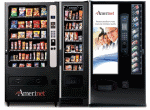
The business or public place without a vending machine is an anomaly in the fast-paced American society. Vendors own the machines and provide the services since the profit is theirs to keep. The machines generate passive income for the vendor since he is not present when the machines make money. Annual sales in the vending industry range between $19 and $29 billion across the country. Individuals or companies might own the machine that accepts money in exchange for the selected product. Most customers never give a second thought to the amount of money earned by the owner.
Serious Business or Hobby
Each vendor has a different idea of the amount of business required to make enough money. Conversations with various vendors reveal whether each person views the vending business as a serious income stream or a side interest. Before responding to an ad promising thousands of dollars in income each month, consider the following:
- Monthly income goal – A desire to make thousands of dollars each month from a vending business will require a significant number of machines. Vendors maintain more than 100 machines to significant monthly income.
- Investment fund – Machines and products must be purchased prior to placement. Many vendors want to sell their existing businesses, but the buyer must have sufficient cash to take over. Building a vending business from scratch will require time and hard work.
- Time – Weekly maintenance of the machines and the products inside requires hours. Someone who works a full-time job might not have enough time to run a vending business on the side.
- Average income per machine – Most vending machines will earn less than $5.00 each week. The “Pareto Principle” applies to vending businesses since 20 percent of the machines will generate the majority of the income. A well-placed machine can generate $100 in a week.
- Clients – Large accounts are lucrative but difficult to win. Existing machines might be poorly managed. A vendor can win new contracts by outperforming former vendors. New clients might come from referrals offered by happy clients.
- Placement – Vendors find a strategy for determining where a machine will make money. One formula to consider is the composition of the workforce. Mostly young men performing physical labor offers a formula for hunger. An office full of weight-conscious women would require a different product set.
- Products – Fruit, candy, soda and coffee are options for vending machines. Fresh products will sell better. A machine with a reputation of stale products will not make money. Each product has a different profit margin that will increase or decrease the profit for the vendor.
- Repairs – A vendor with the ability to repair machines will make more money because the machines will be operational at all times. Spare parts are required for the upkeep of the machines. Time is required to diagnose the problems each machine encounters and conduct repairs.
- Loss – Broken machines and aged products are the primary losses incurred by vendors. Some clients will terminate contracts, but the wise vendor will have plans for immediate placement of the machine.
One Machine or One Hundred Machines
Sellers of vending businesses make remarkable promises concerning the earning potential of the business. Realistic expectations will help the new vendor to determine how many machines will be required to make an acceptable profit.
- One client and one machine – This scenario is the simplest to maintain, but the profit potential is minimal. Buyers want variety, and the machine would have to provide a broad product selection to meet market needs. Machines that offer multiple product lines are expensive.
- One client and multiple machines – In this case, the products would have to be replaced often to keep them fresh. A significant market must be present to support more than one machine in a location.
- Many clients with multiple machines – This scenario is the most profitable, but the time required to maintain the machines and product offerings is significant. Reaching this level requires time and strategy.
Strategy is Critical
Anyone setting out to build a significant vending income must have an effective strategy. Idle machines and empty slots will not provide income. Many factors must be balanced to optimize the operational aspects of the vending business.
- Clients – Vendors should be looking for new contracts before a machine is available. Loss of a client in one area should mean new opportunity for the strategic planner. On the day a machine is pulled from one location, it should be placed in the new client’s location.
- Prices – Each customer set will tolerate different price levels on products. Rapid turnover generates more profits and ensures that the products are fresh. High prices will cause products to sit too long in the machines. Price adjustments take time, but can yield more profit.
- Products – Vendors can choose products to offer in the machines based on client preference or profit margin. Market demand is easier to read since the empty slots in the machines will tell the vendor which products are selling best. Products with minimal profit margins must sell more quickly to justify the space in the machine.
- Equipment – Acquisition of machines can be difficult without a source of gently-used machines. Larger metropolitan areas have a steady source of online ads offering some of the newest machines available. Strategic machine purchases will prevent loss of new accounts.
Vending businesses can provide valuable income in any economic cycle. A captive clientele seeks refreshment from machines in the most unlikely places. Vendors with creative approaches will find many ways to make good money without having to be present. Superior maintenance will ensure that the machine continues to provide steady income for many years.

